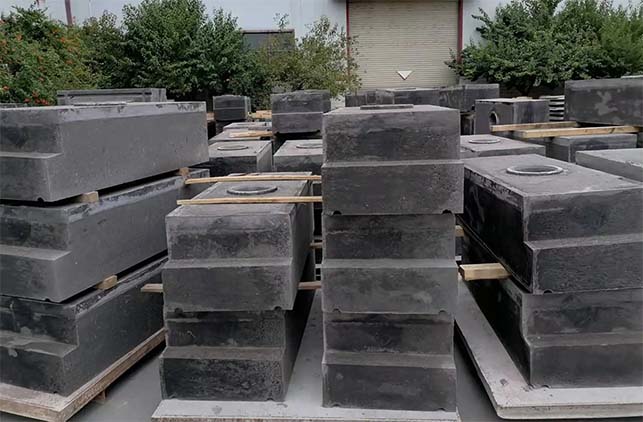Precast Refractory Components are parts of a specific shape made by preforming, baking or sintering refractory materials, and are widely used in high-temperature industrial fields. They have the characteristics of fast installation, high temperature resistance, corrosion resistance, thermal shock resistance, etc. The following are their main application directions:
1. Iron and steel industry
Blast furnace, converter, electric furnace: used for protection of furnace throat, furnace body, iron outlet, slag outlet and other parts.
Hot air duct: prefabricated parts are used for hot air furnace outlet and pipe lining to resist high-temperature air flow erosion.
Ladle, tundish: as lining material to reduce the erosion of molten steel on the container.
Continuous casting equipment: used for key components such as submerged nozzles and long nozzles.
2. Building materials industry
Cement kiln: lining of high-temperature areas such as kiln head hood, kiln tail smoke chamber, and tertiary air duct.
Glass kiln: Refractory protection of melting pool, flow hole, heat storage chamber and other parts.
Lime kiln: lining of preheater and combustion chamber, resisting high temperature and chemical corrosion.
3. Nonferrous metal smelting
Aluminum electrolytic cell: cell wall, cathode and other parts, resisting corrosion of molten aluminum and electrolyte.
Copper and zinc smelting furnace: lining of high temperature areas such as furnace and flue.
Precious metal smelting: used for the protection of induction furnace, reverberatory furnace and other equipment.
4. Chemical and petrochemical industry
Petroleum cracking furnace: furnace lining and radiation section furnace tube support structure.
Coal gasification furnace: resisting corrosion of high temperature synthesis gas (CO, H₂) and slag.
Reactor and incinerator: key components for processing high temperature chemical reactions or hazardous waste.
5. Power industry
Boiler system: cyclone separator and combustion chamber lining of circulating fluidized bed (CFB) boiler.
Waste incinerator: grate and furnace lining, resisting high temperature corrosion and acid gas.
Waste heat power generation system: protection of high-temperature flues and heat exchangers.
6. Ceramic and refractory materials industry
Tunnel kiln, shuttle kiln: prefabricated parts of kiln car table, kiln wall and kiln roof.
High temperature sintering furnace: lining for sintering ceramic and carbon materials.
7. Environmental protection and solid waste treatment
Hazardous waste incinerator: lining of incinerator for treating medical waste and chemical waste.
Fly ash melting furnace: protection of melting furnace for solidifying heavy metals at high temperature.
8. Aerospace and special fields
Rocket engine combustion chamber: ceramic matrix composite parts resistant to high temperature and thermal shock.
High temperature experimental device: lining of simulation equipment under extreme environment.
Advantages of refractory precast parts
1. Quick installation: reduce on-site construction time and improve efficiency.
2. Stable performance: pre-fired in the factory, controllable quality and long life.
3. Thermal shock resistance: adapt to environments with drastic temperature fluctuations.
4. Customized design: Design special-shaped parts according to the equipment structure to reduce joints.
Future trends
High-performance materials: Develop new composite refractory materials such as silicon carbide, silicon nitride, and zirconium oxide.
Lightweight: Reduce heat capacity through porous structures or low-density materials.
Intelligent construction: Customize complex-shaped prefabricated parts with 3D printing technology.
Refractory prefabricated parts play a key role in high-temperature industries. With technological advances, their application scope will be further expanded to emerging fields such as new energy and nuclear industry.



